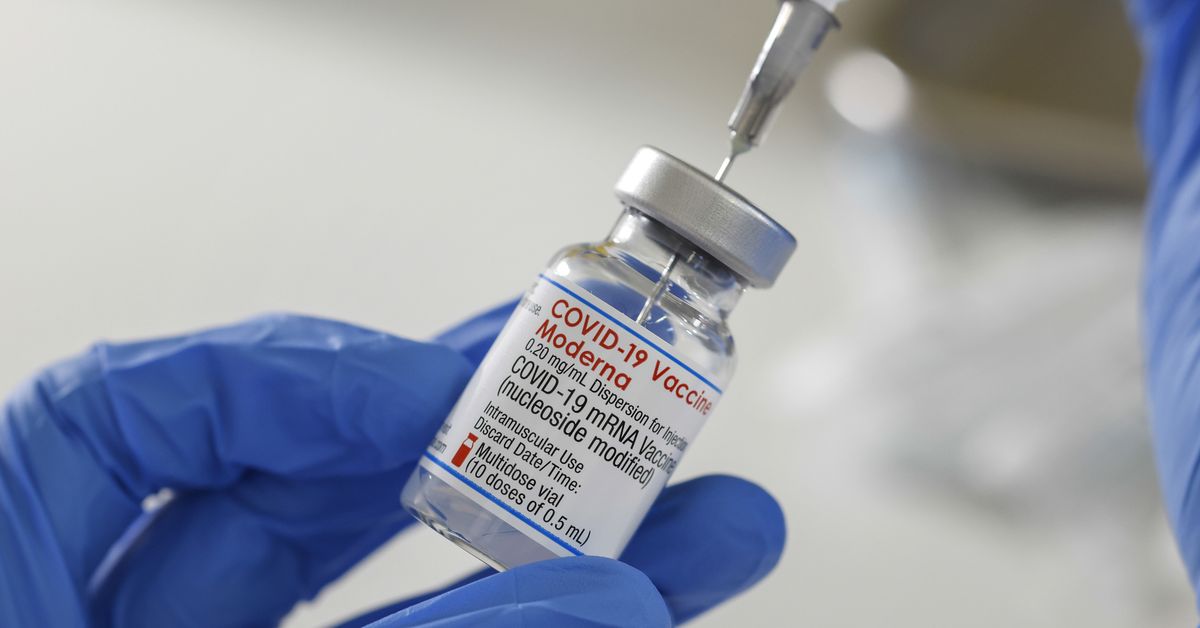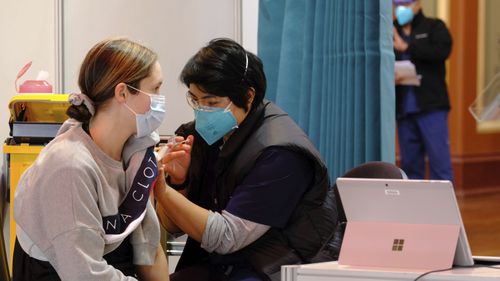Navigation
Install the app
How to install the app on iOS
Follow along with the video below to see how to install our site as a web app on your home screen.
Note: This feature may not be available in some browsers.
More options
Style variation
You are using an out of date browser. It may not display this or other websites correctly.
You should upgrade or use an alternative browser.
You should upgrade or use an alternative browser.
Covid-19 News and Discussions
- Thread starter Yommie
- Start date
Yommie
SpeedLimited
- Oct 2, 2013
- 64,203
- 37,191
- Country of Origin

- Country of Residence

- Thread starter
- #617

Children's Nasal Cells Offer COVID-19 Protection
Important differences in how the nasal cells of young and elderly people respond to the SARS-CoV-2 virus, could explain why children typically
Science
15 Apr 2024 7:07 pm AEST
Children's Nasal Cells Offer COVID-19 Protection
University College London
Important differences in how the nasal cells of young and elderly people respond to the SARS-CoV-2 virus, could explain why children typically experience milder COVID-19 symptoms, finds a new study led by researchers at UCL and the Wellcome Sanger Institute.
The study, published in Nature Microbiology, focused on the early effects of SARS-CoV-2 infection on the cells first targeted by the viruses, the human nasal epithelial cells (NECs).
These cells were donated from healthy participants from Great Ormond Street Hospital (GOSH), University College London Hospital (UCLH) and the Royal Free Hospital, including children (0-11 years), adults (30 – 50 years) and, for the first time, the elderly (over 70 years).
The cells were then cultured using specialised techniques, allowing them to regrow into the different types of cells you originally find in the nose. Using single-cell RNA sequencing techniques that enable scientists to identify the unique genetic networks and functions of thousands of individual cells, the team identified 24 distinct epithelial cell types. Cultures from each age group were then either mock infected or infected with SARS-CoV-2.
The researchers found that, after three days, the NECs of children responded quickly to SARS-CoV-2 by increasing interferon (the body's first line of anti-viral defence) - restricting viral replication. However, this early anti-viral effect became less pronounced with age.
The researchers also found that NECs from elderly individuals not only produced more infectious virus particles, but also experienced increased cell shedding and damage.
The strong antiviral response in the NECs of children could explain why younger people typically experience milder symptoms. In contrast, the increased damage and higher viral replication found in NECs from elderly individuals could be linked to the greater severity of disease observed in older adults.
Project lead, Dr Claire Smith (Associate Professor at UCL Great Ormond Street Institute of Child Health), said: "Our research reveals how the type of cells we have in our nose changes with age, and how this affects our ability to combat SARS-CoV-2 infection. This could be crucial in developing effective anti-viral treatments tailored to different age groups, especially for the elderly who are at higher risk of severe COVID-19."
Co-Senior author, Dr Kerstin Meyer (Wellcome Sanger Institute), said: "By carrying out SARS-CoV-2 infections of epithelial cells in vitro and studying the responses with single cell sequencing, we get a much more detailed understanding of the viral infection kinetics and see big differences in the innate immune response between cell types."
Children infected with SARS-CoV-2 rarely progress to respiratory failure, but the risk of mortality in infected people over the age of 85 remains high, despite vaccination and improving treatment options.
The research underscores the importance of considering age as a critical factor in both research and treatment of infectious diseases.
Co-senior author, Dr Marko Nikolic (UCL Division of Medicine), said: "It is fascinating that when we take away immune cells from nasal samples, and are only left with nasal epithelial cells grown in a dish, we are still able to identify age-specific differences in our body's response to the SARS-CoV-2 between the young and elderly to explain why children are generally protected from severe COVID-19."
Dr Smith added: "Understanding the cellular differences at the initiation of infection is just the beginning. We now hope to investigate the long-term implications of these cellular changes and test therapeutic interventions using our unique cell culture model. This 'gold-standard' system is only possible with the support of our funders and the willingness of participants to provide their samples."
The team suggest that future research should consider how ageing impacts the body's response to other viral infections.
This study was funded by UK Research and Innovation (UKRI), and the National Institute for Health and Care Research (NIHR) Great Ormond Street Hospital Biomedical Research Centre, Wellcome and the Chan Zuckerberg Foundation.
Yommie
SpeedLimited
- Oct 2, 2013
- 64,203
- 37,191
- Country of Origin

- Country of Residence

- Thread starter
- #618

Discovery of Long COVID Brain Fog Cause Hints at Future Treatments
Recent findings that leaky blood vessels in the brain and heightened immune activity are key drivers of long COVID brain fog provide insights into possible targets for treatment.
Discovery of Long COVID Brain Fog Cause Hints at Future Treatments
Leaky blood vessels in the brain and heightened immune activity are key drivers of long COVID brain fog.
NewsPublished: April 15, 2024
| Blake Forman

Credit: cottonbro studio/Pexels
Facebook Twitter LinkedIn Reddit
Share
Listen with
Speechify
0:00
Register for free to listen to this article
Read time: 4 minutes
Brain fog is often described as a feeling of fatigue, forgetfulness and reduced cognitive ability. After the outbreak of the COVID-19 pandemic, patients began to report symptoms such as brain fog months after initially contracting the SARS-CoV-2 virus, a syndrome that came to be termed long COVID.
Now, results from a study into long COVID brain fog suggest that leaky blood vessels in the brains of patients may be the underlying cause of the malady. These findings are likely to change the landscape of how post-viral neurological conditions are treated. The findings were published in Nature Neuroscience.
Long COVID induces an array of neurological symptoms
The World Health Organization estimates that 10-20% of people continue to have, or develop, at least one symptom more than three months after SARS-CoV-2 infection. While common symptoms among patients reporting long COVID can include fatigue, shortness of breath and cognitive dysfunction, over 200 different symptoms have been reported that can have an impact on everyday functioning.Continue reading below...
Article
Life as a Long-Hauler: What Do We Know About Long COVID?
Read moreLong COVID has now become a major public health issue with symptoms of long COVID sometimes lasting for years. According to the United Kingdom’s Office of National Statistics Coronavirus (COVID-19) Infection Survey from March 2023, 41% of patients with self-reported long COVID were still experiencing symptoms 2 years after initial infection with SARS-CoV-2.
Neurological symptoms of long COVID are increasingly being reported. One 2021 study found that, among 236,379 patients diagnosed with COVID-19, 33.62% had demonstrated clinically important neurological or psychiatric dysfunction.
Neurological problems have also been reported in other respiratory viral infections. Evidence also suggests that many neurological conditions can be triggered by viral infections. For example, the Epstein-Barr virus (EBV) has been identified as a leading risk factor for developing multiple sclerosis (MS). Despite this, there is still little understanding of the long-term outcome of neurological problems after SARS-CoV-2 infection.
Determining the cause of post-viral brain fog
To determine the cause of neurological problems resulting from SARS-CoV-2 infection, researchers at Trinity College Dublin and investigators from FutureNeuro examined the integrity of blood vessels in the brains of patients reporting long COVID and those reporting long COVID with brain fog.Want more breaking news?
Subscribe to Technology Networks’ daily newsletter, delivering breaking science news straight to your inbox every day.Subscribe for FREE
Investigating the function of the blood–brain barrier (BBB) in these patients, the researchers established that BBB disruption is evident during acute infection and in patients with long COVID brain fog. To investigate this BBB disruption, the researchers used a novel form of magnetic resonance imaging.
“Prior to our work, it has been difficult to use objective imaging-based methods to observe damage in the brain in patients with post-viral neurological conditions. We now believe that imaging the blood–brain barrier may be useful for a whole range of post-viral conditions,” Matthew Campbell, a professor in genetics and head of genetics at Trinity College Dublin and principal investigator at FutureNeuro, told Technology Networks.
Conducting transcriptomic analysis also revealed dysregulation of the coagulation system and a dampened adaptive immune response in individuals with brain fog. Additionally, expression of inflammatory markers was induced when brain endothelial cells were exposed to serum from patients with long COVID. The researchers suggest that sustained systemic inflammation and persistent localized BBB dysfunction are key features of long COVID associated brain fog.
The results provide a definite pathological basis for long COVID and demonstrate that the neurological symptoms of long COVID are measurable with real and verifiable metabolic and vascular changes in the brain.
“Future studies should be focused on examining in greater detail if BBB restoration aligns with the improvement of clinical symptoms. At present, we don’t know if this is the case. We also don’t know how the BBB changes in other post-viral illnesses and that remains to be elucidated,” said Campbell.
Treatments for long COVID brain fog
Measuring blood vessel integrity is already a clinically useful measurement applied to people suffering from neurological disorders. The researchers at Trinity College Dublin now want to use this measurement to identify those who are at risk of developing neurological symptoms because of post-viral illnesses such as long COVID.By understanding the underlying cause of long COVID brain fog researchers hope to develop targeted therapies to try and repair the integrity of these vessels in the brain. “There are emerging drugs that may be able to restore blood–brain barrier integrity and therefore they may have utility in treating brain fog or indeed other post-viral associated neurological conditions,” said Campbell.
“Long COVID is still such a new disease and we’re only now getting to grips with its long-term effects. We still need a much clearer understanding of how BBB changes align with the clinical progress of long COVID. Aligned with this, we also need to identify a solid panel of biomarkers that can be used in tandem with any imaging approach so that we can accurately predict how patients are faring with/without any potential therapies that emerge in the years to come,” Campbell summarizes.
Yommie
SpeedLimited
- Oct 2, 2013
- 64,203
- 37,191
- Country of Origin

- Country of Residence

- Thread starter
- #619

What Is Long COVID? Understanding the Pandemic’s Mysterious Fallout
Researchers estimate that about 17% of patients who get COVID-19 will go on to develop Long COVID, or the continuation of wide-ranging symptoms after an initial SARS-CoV-2 infection.
What Is Long COVID? Understanding the Pandemic’s Mysterious Fallout

Just weeks after the first cases of COVID-19 hit U.S. shores, an op-ed appeared in The New York Times titled “We Need to Talk About What Coronavirus Recoveries Look Like: They're a lot more complicated than most people realize.” The author, Fiona Lowenstein, is a writer and yoga teacher living in New York City, who wrote about her own illness and the symptoms she was left with once she was released from the hospital. “In the weeks since I was hospitalized for the coronavirus, the same question has flooded my email inbox, texts and direct messages: Are you better yet? I don’t yet know how to answer.”
She was better, she wrote on April 13, 2020, but she wasn’t well. And others she was in touch with were having the same issue. Unlike most diseases, Long COVID was first described not by doctors, but by the patients themselves. Even the term “Long COVID” was coined by a patient. Dr. Elisa Perego, an honorary research fellow at University College in London, came up with the hashtag #LongCOVID when tweeting about her own experience with the post-COVID syndrome. The term went viral and suddenly social media, and then the media itself, was full of these stories.
Complaints like "I can't seem to concentrate anymore" or "I'm constantly fatigued throughout the day" became increasingly common, seemingly appearing out of nowhere. With nothing abnormal turning up from their many thorough lab tests, patients and their physicians were left feeling helpless and frustrated.
The World Health Organization (WHO) has defined Long COVID as the "continuation or development of new symptoms three months after the initial SARS-CoV-2 infection, with these symptoms lasting for at least two months with no other explanation." This deliberately broad definition reflects the complex nature of this syndrome. We now understand that these symptoms are wide-ranging, including heart palpitations, cough, nausea, fatigue, cognitive impairment (commonly referred to as "brain fog"), and more. Also, many who experience Long COVID following an acute infection face an elevated risk of such medical complications as blood clots and (type 2) diabetes.
As of March 2024, it’s estimated that about 17% of patients who get COVID-19 will go on to develop post-acute COVID-19 syndrome, the medical term for Long COVID. Data from the Centers for Disease Control and Prevention (CDC) suggest that Long COVID disproportionately affects women, and individuals between the ages of 40 and 49 have the highest reported rates of developing this post-acute infection syndrome.
Long COVID represents a new clinical challenge

Ebony Dix, MD, a Yale School of Medicine (YSM) assistant professor of psychiatry and the medical director of the geriatric psychiatry inpatient unit at Yale New Haven Hospital, said: "Unfortunately, it is not easy to say who is going to get Long COVID and who isn't." She also emphasized that "it can be overlooked and attributed to a preexisting condition. Sometimes the only thing that patients have in their history is a positive COVID test."
Dr. Dix recalled a patient she treated in the COVID psychiatry unit whose unanticipated clinical decline began with increasing fatigue during physical therapy sessions, ultimately necessitating more care over several weeks. Dr. Dix noted, "Long COVID requires time for things to settle down. It might take several months to get back to baseline." Making timely changes to a patient’s treatment plans was essential to helping her patients get back to good health, she said.
A major challenge with Long COVID is how difficult it can be to diagnose. Determining whether new-onset symptoms, such as fatigue or weakness, are related to an underlying condition or entirely attributed to a prior COVID infection is the greatest challenge for those who care for these patients. This is, in large part, due to the lack of research surrounding the topic.
Defining a basis for Long COVID with clinical research
Inderjit Singh, MBChB, a YSM assistant professor specializing in pulmonary, critical care, and sleep medicine, and director of the Pulmonary Vascular Program, is actively engaged in clinical trials aimed at uncovering the fundamental underpinnings of Long COVID. In one research study, patients suffering from unexplained fatigue and shortness of breath undergo exhaustive exercise testing. In order to be enrolled in this study, patients need to have already completed a substantial work-up, including an echocardiogram, pulmonary function testing, chest CT scans, and more, all which result in no alternative diagnosis.Through this work, a significant revelation emerged. They observed that patients grappling with Long COVID and facing exercise difficulties were unable to efficiently extract oxygen from their bloodstream during physical exertion. This discovery identifies a specific cause underlying the biological underpinnings of Long COVID.
Recognizing the impracticality of conducting comprehensive exercise tests for every Long COVID patient, Dr. Singh, along with other researchers, is focused on the identification of blood-based markers to assess the severity of Long COVID. For example, a research group, led by Akiko Iwasaki, PhD, Sterling Professor of Immunobiology and Molecular, Cellular, and Developmental Biology, and director of the Center for Infection & Immunity at YSM, most recently created a new method to classify Long COVID severity with circulating immune markers.
Further investigations conducted by Dr. Singh's team identified distinctive protein signatures in the blood of Long COVID patients, which correlated with the degree of Long COVID severity. Researchers identified two major and distinct blood profiles among the patients. Some of them exhibited blood profiles indicating that excessive inflammation played a prominent role in their condition, while others displayed profiles indicative of impaired metabolism. Dr. Singh raises a pressing question: "Do we prioritize treating the inflammation or addressing the metabolic defects?"
Although his research findings and those of his peers are progressively unraveling the mysteries of Long COVID, he acknowledges that "significant challenges persist in defining this syndrome.”
Why does Long COVID happen?
The symptoms of Long COVID can vary significantly from one patient to another. Some individuals may be so fatigued that they find it difficult to get out of bed each morning. Others experience heart palpitations, lightheadedness, nausea, vomiting, diarrhea, or brain fog. This broad spectrum of symptoms—more than 200 documented—has led to various hypotheses about the underlying mechanisms at play.Researchers currently believe that the impairment of a spectrum of key bodily functions may contribute to these diverse symptoms. These potential mechanisms include compromised immune system function, damage to blood vessels, and direct harm to the brain and nervous system. Importantly, it's likely that most patients experience symptoms arising from multiple underlying causes, which complicates both the diagnosis and treatment of Long COVID.
How can Long COVID be treated?
While the diagnosis and treatment of Long COVID remain challenging, the landscape of treatment options is evolving. At Yale’s Multidisciplinary Long COVID Care Center, a team, including respiratory therapists, physical therapists, and clinical social workers, along with an internist, work together to provide a comprehensive evaluation of each patient. Treatment approaches can vary widely and may encompass medications, supplements, physical therapy, or other interventions. Each regimen is designed to meet the specific presentation of Long COVID in each patient.Dr. Singh’s apt summarization of the situation? "I don't think there's a magic bullet for it." Effective management of Long COVID necessitates a multidisciplinary approach that harnesses the expertise of a wide variety of specialists, working together to provide tailored care and support for these patients.
Brooks Leitner is an MD/PhD candidate at Yale School of Medicine.
The last word from Lisa Sanders, MD:
I’m the internist who sees patients at Yale New Haven Health’s Multidisciplinary Long COVID Care Center. In our clinic, patients are examined by a variety of specialists to determine the best next steps for these complex patients. Sometimes that entails more testing. Often patients have had extensive testing even before they arrive, and far too often—when all the tests are normal—both doctors and patients worry that their symptoms are “all in their head.”One of our first tasks is to reassure patients that many parts of Long COVID don’t show up on tests. We don’t know enough about the cause of many of these symptoms to create a test for them. The problem is not with the patient with the symptoms, but of the science surrounding them.
If any good can be said to come out of this pandemic, it will be a better understanding of Long COVID and many of the other post-acute infection syndromes that have existed as long as the infections themselves.
Yommie
SpeedLimited
- Oct 2, 2013
- 64,203
- 37,191
- Country of Origin

- Country of Residence

- Thread starter
- #620
COVID-19 kills New Brunswicker aged 45-64, 2 youth among those hospitalized by flu
COVID activity remains moderate and influenza activity stable, latest Respiratory Watch report says

Bobbi-Jean MacKinnon · CBC News · Posted: Apr 16, 2024 12:06 PM EDT | Last Updated: 2 hours ago

A total of 1,448 people have now been hospitalized for or with COVID-19 since the respiratory season began on Aug. 27, 94 of whom required intensive care, while the flu has sent 534 to hospital, with 50 of them admitted to ICU. (Patrick Lacelle/Radio-Canada)
Social Sharing
- X
comments
A New Brunswicker aged 45 to 64 has died from COVID-19, while the flu sent eight people to the hospital, including two youth aged five to 19, updated data from the province Tuesday shows.
"COVID-19 activity remains moderate," according to the Respiratory Watch report. "Some indicators (number of cases, percent positivity, and hospitalizations) decreased slightly during the current reporting period, between March 31 and April 6.
Influenza activity remained "relatively stable," it says.
The latest COVID death raises the provincial pandemic total to at least 1,028. The actual number is unclear because the Department of Health counts only people who die in hospital as COVID deaths.
Eleven people were hospitalized because of COVID or for something else and later tested positive for the virus. That's down from 13 hospitalizations in the previous report.
Two people required intensive care, up from none.

New Brunswick began offering spring COVID-19 vaccine booster doses on April 2 to those considered most at risk of severe illness. (Joe Burbank/The Associated Press)
Of those hospitalized, two were aged 20 to 44, one was 45 to 64, and the other eight were 65 or older, including the two in ICU, the report shows.
Four lab-confirmed COVID outbreaks were declared during the reporting week, up from two. Three were in nursing homes and one was in a facility described only as "other."
There were 25 new cases of COVID confirmed through PCR (polymerase chain reaction) lab tests, the same number as a week ago.
The positivity rate — or the percentage of lab tests performed that produced a positive result — is three per cent, down from four.
About 900 COVID-19 vaccines were administered in the past week, raising the total to 149,984 vaccinations since Oct. 4, the Department of Health said.
Spring boosters have been available since April 2 to New Brunswickers considered most at risk of severe illness.
Spring doses will be available until June 15, followed by a fall campaign, the Department of Health has said.
2 young adults in ICU with flu
No flu deaths were reported between March 31 and April 6.The eight flu hospitalizations represents a jump from three in the previous report. Two people were admitted to intensive care, up from none.
In addition to the two youth hospitalized, there were also two people aged 20 to 44, both of whom required ICU, two aged 45 to 64, and two aged 65 or older.
One flu outbreak was reported, down from two a week ago. It was in a nursing home, the report shows.
There was also one new influenza-like illness school outbreak, up from none. No details are provided, but school outbreaks are based on 10 per cent absenteeism because of influenza-like illness symptoms, according to the report.
New flu cases confirmed by lab tests decreased to 106 from 115, and the positivity rate is 10 per cent, down from 12.
Eleven of the new cases were influenza A and 95 were influenza B.
These raise the total number of flu cases in the province since the respiratory season began on Aug. 27 to 3,389.
About 180 New Brunswickers rolled up their sleeves for the flu shot in the past week, data from the Department of Health shows. A total of 223,043 people have now been vaccinated against the flu since Oct. 4.
Yommie
SpeedLimited
- Oct 2, 2013
- 64,203
- 37,191
- Country of Origin

- Country of Residence

- Thread starter
- #621
Nosing Out Why Kids Are Less Harmed by COVID
By HealthDay
April 16, 2024, at 7:28 a.m.

Nosing Out Why Kids Are Less Harmed by COVID
More
By Dennis Thompson HealthDay Reporter

HEALTHDAY
TUESDAY, April 16, 2024 (HealthDay News) -- The nose appears to know when it comes to why children typically have milder cases of COVID-19 than seniors, a new study finds.
Cells lining the inside of the nose are more likely to have a prompt immune response to COVID in young people than in old people, laboratory results show.
This enhanced response occurred even when researchers screened out the immune cells that would naturally exist alongside the cells lining the nose, which are called nasal epithelial cells, researchers said.
“It is fascinating that when we take away immune cells from nasal samples, and are only left with nasal epithelial cells grown in a dish, we are still able to identify age-specific differences in our body’s response to [COVID] SARS-CoV-2 between the young and elderly to explain why children are generally protected from severe COVID-19,” said co-senior researcher Dr. Marko Nikolic, a respiratory specialist with the University College London Division of Medicine.
For the study, researchers cultured nasal cells donated from healthy children, adults and seniors.
The cell cultures were then exposed to the COVID coronavirus, and their responses tracked in the lab.
After three days, the nasal cells of children responded promptly to the virus by increasing interferon, a signaling protein that serves as the body’s first line of defense against invading viruses. Interferons cause nearby cells to heighten their own anti-viral defenses, boosting immune defense.
However, this early anti-viral response became less pronounced with age. In fact, the nasal cells of seniors tended to produce more infectious viral particles, aiding in the spread of the virus throughout the body.
The stronger antiviral response in children’s nasal cells could explain why younger people have milder COVID symptoms, researchers said.
Further, the increased damage and higher viral replication found in the nasal cells of seniors could show why they are at greater risk for severe COVID infections.
Children with COVID rarely suffer from respiratory failure requiring ventilation. On the other hand, those older than 85 are at great risk of dying from COVID, even with vaccination.
“Our research reveals how the type of cells we have in our nose changes with age, and how this affects our ability to combat SARS-CoV-2 infection,” lead researcher Claire Smith, an associate professor with the University College London Great Ormond Street Institute of Child Health, said in a news release.
“This could be crucial in developing effective anti-viral treatments tailored to different age groups, especially for the elderly who are at higher risk of severe COVID-19,” Smith added in a university news release.
Future studies should consider how aging affects the body’s response to other viral infections, the researchers concluded.
The new study was published April 15 in the journal Nature Microbiology.
Yommie
SpeedLimited
- Oct 2, 2013
- 64,203
- 37,191
- Country of Origin

- Country of Residence

- Thread starter
- #622
Midland Public Schools to avoid ‘COVID cliff’
District receives nearly $4M in additional funds
By Ben Jodway,Staff WriterUpdated April 16, 2024 1:38 p.m.Midland Public Schools Board of Ecucation listens to a budget workshop during its regular meeting on Monday, April 15. From left to right, Jennifer Ringgold, Brad Blasy, Scott McFarland, Phil Rausch, John Hatfield, Jon Lauderbach, Ann Horowitz, and Interim Superintendent Penny Miller-Nelson.
Ben Jodway/Midland Daily News
As COVID-era federal funding and state funding dry up, many schools are seeing what’s called the “COVID cliff,” whereby funds will suddenly drop off. For some school districts, programs and even staff members could reportedly be cut.
Skip Ad
However, it appears Midland Public Schools will avoid that cliff, said Associate Superintendent Brian Brutyn during a budget workshop meeting with the Board of Education on Monday, April 15.
Community Connection Sale: Only 25¢ for unlimited digital access!
Act Now
The district avoided the fall-off due to “something odd” that happened, he said. Midland Public Schools became a “full recipient of the at-risk formula” and received a 31-AA grant for the first time along with additional funding from another grant.
ADVERTISEMENT
Article continues below this ad
In total, the district received nearly $4 million in additional funding.
“We made very strategic decisions to spend some of those revenues, but also to defer some of those revenues,” Brutyn said to the board members. “The deferral of those revenues mean that we will present to you in May and show you that we have the ability to not only sustain, but also enhance almost all of our ESSER (Elementary and Secondary School Emergency Relief) initiatives for another 2-3 years.”
In respect to the district’s general fund, Brutyn said it is currently in a “solid fiscal position.”
“Things got a little bit weird, but still a very, very healthy fund balance right now,” he said.
ADVERTISEMENT
Article continues below this ad
Also of note, Brutyn said the district is predicting a decrease in enrollment of 35 students.
Other business
- The board approved a motion for replacing flooring throughout MPS. The project was awarded to Vantg Flooring and Interiors of Midland for $81,000. Capital improvement funds will be used.
- The board approved a motion for renewing a contract with Chartwells for food service. Schools must rebid for food service contracts every five years.
- The board approved Habitat for Humanity’s purchase of the property at Dauer and Shreeve streets, where the Franklin Center used to be located. The contract also allows Habitat for Humanity to work with Midland Public Schools building trades students for the next decade.
- The board approved the purchase of a new video scoreboard for the pool located at Dow High School. The project was awarded to Colorado Time Systems of Loveland, Colorado for $64,300. Capital improvement funds will be used.
- The board approved the purchase of new interactive whiteboards for Plymouth Elementary and Central Park Elementary. It costs the district $50,230 and uses Title I funds.
- The board approved the purchase of six Dell R760 servers, three Dell Powerstore 500T storage area networks, an external tape drive and four network switches. This would replace servers and digital storage at the district. It costs the district $447,700.62 and uses Series III of the 2015 bond.
- The board entered a closed session regarding legal opinion at the end of the meeting.
Yommie
SpeedLimited
- Oct 2, 2013
- 64,203
- 37,191
- Country of Origin

- Country of Residence

Yommie
SpeedLimited
- Oct 2, 2013
- 64,203
- 37,191
- Country of Origin

- Country of Residence

- Thread starter
- #624
Log in to Facebook
Log in to Facebook to start sharing and connecting with your friends, family and people you know.
 www.facebook.com
www.facebook.com
Dear Montréal, Québec COVID-19 Updates members,
I hope you enjoyed the once-in-a lifetime total solar eclipse.
I have decided to close the group 2 weeks earlier than scheduled so Tuesday, April 16, 2024 at 11:59 pm EDT (my birthday) considering the COVID-19 positivity rates are now down to 2.0% after the Easter gatherings in Québec and I want to take time off from this topic.
I am not certain to reopen the COVID-19 group next fall and winter.
This group with more than 36K members was very helpful at the height of the health emergency (once-in-a-lifetime pandemic) and I may reopen this group for the wrong reasons for the next emergency situation in Montreal to better inform the population.
I thank you for following the group.
I am forever grateful for the moderators
Sabrina BonVivant Marie-Claire Hogan Martin Liu.
It was a great experience in administering the group for the last 4 years.
See you somewhere in the future.
Goodbye!
Richard
@everyone
Khansaheeb
Elite Member
- Dec 14, 2008
- 19,932
- 20,985
- Country of Origin

- Country of Residence

Only god knows what they really stuck in the vaccines:-

 www.theepochtimes.com
www.theepochtimes.com

Modified RNA in COVID Vaccines May Contribute to Cancer Development: Review
In a review published on April 5, researchers argue that modification to mRNA causes immune suppression that may contribute to cancer development.
Yommie
SpeedLimited
- Oct 2, 2013
- 64,203
- 37,191
- Country of Origin

- Country of Residence

- Thread starter
- #626
Only god knows what they really stuck in the vaccines:-

Modified RNA in COVID Vaccines May Contribute to Cancer Development: Review
In a review published on April 5, researchers argue that modification to mRNA causes immune suppression that may contribute to cancer development.www.theepochtimes.com
Interesting. mRNA drug is very dangerous. China does not allow it.
Yommie
SpeedLimited
- Oct 2, 2013
- 64,203
- 37,191
- Country of Origin

- Country of Residence

- Thread starter
- #627

Coroner probes Moderna vaccine link to young Melbourne woman's death
Coroner probes Moderna vaccine link to young Melbourne woman's death
By Emily Woods • AAP1:45pm Apr 17, 2024
Moderna has engaged its own medical expert as it faces an inquest in Victoria, which is investigating whether a 21-year-old woman died because of its COVID-19 vaccine.
The pharmaceutical company's lawyers appeared before the Coroners Court in Melbourne today for a hearing into the death of Natalie Boyce.
Boyce received her third COVID-19 jab on February 18, 2022, which was the Moderna mRNA vaccine, counsel assisting Jessika Syrjanen told the court.
READ MORE: Fire destroys golf clubhouse north-west of Melbourne

About a week later, she went to see a GP after vomiting for five days, suffering aching pain and at one point fainting.
In the following weeks, Boyce went to hospital and a medical centre as her symptoms of vomiting, pain and fainting persisted.
On March 5, she went to Mulgrave Private Hospital, after suffering chest pain and shortness of breath, and was transferred to The Alfred where she was diagnosed with fulminant myocarditis.
YOU MAY ALSO LIKE
Recommended by
 How Xi Jinping plans to overtake AmericaSPONSORED | The Economist
How Xi Jinping plans to overtake AmericaSPONSORED | The Economist 2024 Omax's Professional Microscope Models line upOmax Microscopes is happy to announce their 2024 featured product line-up for the stereo microscope and compound microscope series.SPONSORED | Omaxmicroscope.com
2024 Omax's Professional Microscope Models line upOmax Microscopes is happy to announce their 2024 featured product line-up for the stereo microscope and compound microscope series.SPONSORED | Omaxmicroscope.com 'Never Going Back to Prime’—Why 20,000 Users Prefer This Shopping SecretThis simple trick can save tons of money on Amazon, but most prime members are ignoring itSPONSORED | onlineshoppingtools.com
'Never Going Back to Prime’—Why 20,000 Users Prefer This Shopping SecretThis simple trick can save tons of money on Amazon, but most prime members are ignoring itSPONSORED | onlineshoppingtools.comThe 21-year-old's condition deteriorated after she underwent surgery to remove a clot, then during an MRI she suffered a heart attack.
She could not be revived and Boyce was declared dead on March 27.
A forensic pathologist performed a post-mortem on Boyce, finding she died from acute myocarditis infarction.
The autopsy found "given the close proximity in time due to vaccine, a vaccine-related myocarditis cannot be excluded".
But the report also said this could not be diagnosed post-mortem.
In February this year, Moderna engaged its own cardiologist to provide an expert opinion to the court and asked for extended leave to provide a report from them.
READ MORE: Assault involving 'edged weapon' unfolds at Melbourne shopping centre

Syrjanen said Moderna's report differed to other medical evidence before the coroner on Boyce's cause of death and medical management in the lead-up, but she did not detail how.
"Moderna submitted in a letter to the court that 'the conclusion from the autopsy report should be accepted: that a definitive cause for Boyce's myocarditis cannot be identified'," she told the court.
"I seek clarification from Moderna's legal representatives today as to Moderna's current position and whether that has changed."
Moderna's lawyer Jesse Rudd said he could not give instant clarification on the company's position.
"That's the first I've heard of it," he replied, asking for time to seek advice.
All parties were given eight weeks to read through Moderna's report and consider their positions.
The case will return on July 17 for mention before Coroner Catherine Fitzgerald.
Yommie
SpeedLimited
- Oct 2, 2013
- 64,203
- 37,191
- Country of Origin

- Country of Residence

- Thread starter
- #628

Vaccines saved almost 20,000 lives during early Omicron wave
'One of the greatest achievements of medical science': Vaccines saved almost 20,000 lives in NSW during early Omicron wave, new study claims
By Daniel Jeffrey10:19am Apr 17, 2024
Australia's COVID-19 vaccination program saved the lives of almost 20,000 people in NSW alone between August 2021 and July 2022, according to new research released today.
According to the computer simulations done by Victoria's RMIT and Monash universities, vaccines prevented 17,760 deaths in NSW's over-50 population during those 12 months.
That period included the peak of the Delta outbreak, the lifting of the state's longest lockdown, and the emergence of the Omicron subvariant.
READ MORE: Woman dead, two others in hospital after ingesting drink at Victorian retreat

The study said that, without vaccines, 21,250 people aged over 50 would have died from the virus in the state over those 12 months — almost six times the actual 3495 deaths in that age group.
"The rapid development of safe and effective vaccines for COVID-19 is perhaps one of the greatest achievements of medical science," Paul Griffin, director of infectious diseases at Mater Health Services, who wasn't involved in the study, said.
"Given the COVID-19 vaccines, like most vaccines in fact, are not 'perfect' in that they do have some limitations including not completely preventing infection in all recipients, and not unexpectedly they have been responsible for some adverse events, many have been critical of them.
Yommie
SpeedLimited
- Oct 2, 2013
- 64,203
- 37,191
- Country of Origin

- Country of Residence

- Thread starter
- #629
04-18-2024NEWS
4 years later it’s official: WHO says COVID spreads ‘through the air’
About 500 experts in fields such as physics and public health agreed on the definition.

FILE PHOTO: A visitor walks past an illuminated coronavirus (COVID-19) model as he visit the “Mini-Worlds on the Way of Illumination” (Mini-Mondes en voie d’illumination) exhibition during the Light Festival preview at the Jardin des Plantes (Botanical garden) in Paris, France, November 12, 2022. [Photo: Gonzalo Fuentes/File Photo/REUTERS]
- https://www.facebook.com/sharer.php...ough-air&app_id=178479832213933&display=popup
- https://twitter.com/intent/tweet?ur...ial:+WHO+says+COVID+spreads+‘through+the+air’
- https://www.linkedin.com/shareArtic...ial:+WHO+says+COVID+spreads+‘through+the+air’
The World Health Organization and around 500 experts have agreed for the first time what it means for a disease to spread through the air, in a bid to avoid the confusion early in the COVID-19 pandemic that some scientists have said cost lives.
The Geneva-based U.N. health agency released a technical document on the topic on Thursday. It said it was the first step towards working out how to better prevent this kind of transmission, both for existing diseases like measles and for future pandemic threats.
The document concludes that the descriptor “through the air” can be used for infectious diseases where the main type of transmission involves the pathogen travelling through the air or being suspended in the air, in line with other terms such as “waterborne” diseases, which are understood across disciplines and by the public.
Almost 500 experts contributed to the definition, including physicists, public health professionals, and engineers, many of whom disagreed bitterly over the topic in the past.
Agencies have historically required high levels of proof before calling diseases airborne, which required very stringent containment measures; the new definition says the risk of exposure and severity of disease should also be considered.
Past disagreements also centred around whether infectious particles were “droplets” or “aerosols” based on size, which the new definition moves away from.
During the early days of COVID in 2020, around 200 aerosol scientists publicly complained that the WHO had failed to warn people of the risk that the virus could spread through the air. This led to an overemphasis on measures like handwashing to stop the virus, rather than focusing on ventilation, they said.
By July 2020, the agency said there was “evidence emerging” of airborne spread, but its then chief scientist Soumya Swaminathan—who began the process to get a definition—later said the WHO should have been more forceful “much earlier.”
Her successor, Jeremy Farrar, said in an interview that the new definition was about more than COVID, but he added that at the beginning of the pandemic there was a lack of evidence available and experts including the WHO acted in “good faith.” At that time, he was head of the Wellcome Trust charity and advised the British government on the pandemic.
Farrar said getting the definition agreed among experts from all disciplines would allow discussions to begin about issues such as ventilation in many different settings, from hospitals to schools.
He compared it to the realization that blood-borne viruses like HIV or hepatitis B could be spread by medics not wearing gloves during procedures.
“When I started out, medical students, nurses, doctors, none of us wore gloves to take blood,” he told Reuters. “Now it is unthinkable that you wouldn’t wear gloves. But that came because everyone agreed on what the issue was, they agreed on the terminology . . . [The change in practice] came later.”
—Jennifer Rigby, Reuters
Yommie
SpeedLimited
- Oct 2, 2013
- 64,203
- 37,191
- Country of Origin

- Country of Residence

- Thread starter
- #630

Flu and COVID-19 surveillance report published
Weekly national influenza and COVID-19 report, COVID-19 activity, seasonal flu and other seasonal respiratory illnesses.
News story
Flu and COVID-19 surveillance report published
Weekly national influenza and COVID-19 report, COVID-19 activity, seasonal flu and other seasonal respiratory illnesses.From:UK Health Security Agency Published 7 October 2021 Last updated 18 April 2024 — See all updates

Latest update
This COVID-19 and flu surveillance bulletin brings together the latest surveillance data, along with the latest public health advice for COVID-19 and flu.The flu and COVID-19 surveillance report has been published here.
COVID-19 surveillance data for week 15
COVID-19 activity remained at low levels.SARS-CoV-2 positivity increased to 4.2% compared with 3.9% in the previous week. This is based on a percentage of people who test positive among those with symptoms tested at sentinel ‘spotter’ laboratories, reported through the Respiratory DataMart surveillance system.
COVID-19 hospitalisations decreased slightly to 1.77 per 100,000 compared with 1.87 per 100,000 in the previous week.
COVID-19 intensive care unit (ICU) admissions remained low and stable at 0.06 per 100,000 in week 15.
The total number of confirmed COVID-19 acute respiratory incidents remained stable compared to the previous week, with 12 incidents reported in England during week 15.
The highest hospital admission rate regionally is currently in the West Midlands at 3.20 per 100,000.
Those aged 85 years and over had the highest hospital admission rate, which decreased to 20.56 per 100,000. Other age groups show a mixed picture.
The Spring 2024 COVID-19 vaccination programme is now live. Those eligible can visit Book COVID-19 vaccination appointment or can use the NHS app to book their appointment. Those without access to the internet can call 119 to book an appointment. NHS will be sending texts, emails and NHS app messages to remind those eligible to book their appointments but do not have to wait to be contacted. Vaccination will end on 30 June 2024.
The eligible cohorts include:
- adults aged 75 years and over by 30 June 2024
- residents in care homes for older adults
- individuals aged 6 months and over who are immunosuppressed.
Flu surveillance data for week 15
Overall, influenza activity decreased across most indicators.Influenza positivity decreased to 2.7% in week 15 compared with 3.5% in the previous week. This is based on a percentage of people who test positive among those with symptoms tested at sentinel ‘spotter’ laboratories, reported through the Respiratory DataMart surveillance system.
The total number of confirmed influenza acute respiratory incidents decreased compared to the previous week, with 6 incidents reported in England during week 15.
Overall, influenza hospitalisations decreased further to 0.72 per 100,000 compared with 1.18 per 100,000 in the previous week and was within the baseline range (less than 1.57 per 100,000).
Influenza ICU admissions remained low at 0.03 per 100,000 in week 15.
Emergency department (ED) attendances for influenza-like-illness (ILI) decreased nationally.
Dr Mary Ramsay, Director of Public Health Programmes at UKHSA, said:
This week flu has decreased, and COVID-19 remains low but is still circulating. COVID-19 is still causing hospitalisations and severe illness particularly among those most at risk. I urge all those aged 75 and over and those who have a weakened immune system to book a vaccination as soon as possible – ensuring they top up their immunity to give them the best possible protection.
Staying at home when you have symptoms of flu or COVID-19 helps protect others, especially those who are vulnerable. If you need to go out when you are unwell, consider wearing a mask around other people.
Users who are viewing this thread
Total: 1 (members: 0, guests: 1)
Pakistan Defence Latest
-
-
-
-
Breaking news: Malakand 10 diplomates from different countries attacked...All safe (2 Viewers)
- Latest: hussain0216
Country Watch Latest
-
-
-
Dr. Shahiduzzaman: in order to change India’s habitual perception, our only answer as I feel is nuclearization. (4 Viewers)
- Latest: Chandragupt Maurya
-
-
Latest Posts
-
-
-
Hindutva Lobby Flexes its Muscle in California by Brofessor Riazul Haq sb (3 Viewers)
- Latest: Guru Dutt
-
-
